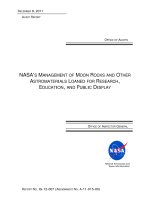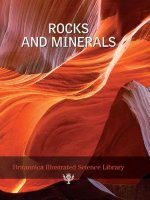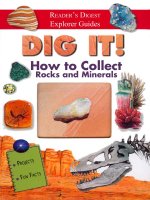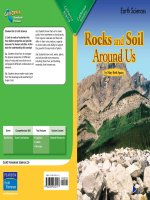Rocks and Minerals Eyewitness
Bạn đang xem bản rút gọn của tài liệu. Xem và tải ngay bản đầy đủ của tài liệu tại đây (46.69 MB, 73 trang )
ROCK &
MINERAL
Eyewitness
(c) 2011 Dorling Kindersley. All Rights Reserved.
Eyewitness
ROCKS &
MINERALS
(c) 2011 Dorling Kindersley. All Rights Reserved.
Slice from
septarian nodule
Garnet-chlorite schist
Cinnabar
Hematite
Gypsum desert rose
Wenlock limestone
with triolobite fossils
Granite
(c) 2011 Dorling Kindersley. All Rights Reserved.
Sulfur
Labradorite
Nephrite
“tiki”
Obsidian
Pyrite
Geothite
Cut
tourmalines
Opal
Eyewitness
ROCKS &
MINERALS
Written by
Dr R.F. SYMES
and the staff of the
Natural History Museum,
London
DK Publishing
(c) 2011 Dorling Kindersley. All Rights Reserved.
Magnifying lens
Mixed rough
and polished
pebbles
LONDON, NEW YORK,
MELBOURNE, MUNICH, and DELHI
Project editor Janice Lacock
Art editor N
eville Graham
Managing art editor J
ane Owen
Special photography C
olin Keates (Natual History
Museum, London) and Andreas Einsiedel
Editorial consultants
Dr. R.F. Symes (Natural History Museum, London)
and Dr. Wendy Kirk (University College London)
Revised Edition
Managing editors A
ndrew Macintyre, Camilla Hallinan
Managing art editors Jane Thomas, Martin Wilson
Editors A
ngela Wilkes, Sue Nicholson
Art editor C
atherine Goldsmith
Production J
enny Jacoby, Georgina Hayworth
Picture research A
ngela Anderson, Claire Bowers, Kate Lockley
DTP designers S
iu Chan, Andy Hilliard, Ronaldo Julien
U.S. editor E
lizabeth Hester
Senior editor B
eth Sutinis
Art director D
irk Kaufman
U.S. production C
hris Avgherinos
U.S. DTP designer M
ilos Orlovic
This Eyewitness ® Guide has been conceived by
Dorling Kindersley Limited and Editions Gallimard
This edition first published in the United States in 2008
by DK Publishing, 375 Hudson Street, New York, New York 10014
Copyright © 1988, © 2004, © 2008 Dorling Kindersley Limited
08 10 11 12 10 9 8 7 6 5 4 3 2
ED581 — 02/08
All rights reserved under International and Pan-American Copyright Conventions.
No part of this publication may be reproduced, stored in a retrieval system, or
transmitted in any form or by any means, electronic, mechanical, photocopying,
recording, or otherwise, without the prior written permission of the copyright
owner. Published in Great Britain by Dorling Kindersley Limited.
A catalog record for this book is available from the Library of Congress.
ISBN 978-0-7566-3777-4 (HC) 978-0-7566-0718-0 (Library Binding)
Color reproduction by Colourscan, Singapore
Printed and bound in China by Toppan Printing Co. (ShenZhen), Ltd.
Chisel
Geologist’s hammer
Chalcedony cameo
Discover more at
(c) 2011 Dorling Kindersley. All Rights Reserved.
Contents
Cut citrine
Baryte
desert rose
Clear topaz
Cut amethyst
44
Crystals
46
The growing crystal
48
The properties of minerals
50
Gemstones
52
Decorative stones
54
Lesser-known gems
56
Ore minerals and metals
58
Precious metals
60
Cutting and polishing stones
62
Collecting rocks and minerals
64
Did you know?
66
Rock or mineral?
68
Find out more
70
Glossary
72
Index
6
The Earth
8
What are rocks and minerals?
10
How rocks are formed
12
Weathering and erosion
14
Rocks on the seashore
16
Igneous rocks
18
Volcanic rocks
20
Sedimentary rocks
22
Limestone caves
24
Metamorphic rocks
26
Marble
28
The first flint tools
30
Rocks as tools
32
Pigments
34
Building stones
36
The story of coal
38
Fossils
40
Rocks from space
42
Rock-forming minerals
(c) 2011 Dorling Kindersley. All Rights Reserved.
6
The Earth
One of the nine known
planets that revolve around
the Sun, the Earth is thought
to be about 4.6 billion years
old. Geology is the study of
the history of the Earth. Because rocks can
provide valuable information about the
Earth in previous times, geologists study
them and work out the processes and
events that produced them. As we can
currently bore only a few miles into the
crust, or outer shell, we cannot sample
rocks from the mantle (the inner shell)
directly. The rocks and minerals shown
here come from many locations and
introduce important features that are
explained in more detail later in the book.
MINERAL ORES
These are the source of
most useful metals. For
more information, see
pages 56-57.
PRECIOUS METALS
Platinum, silver, and
gold are rare and
valuable metals. For
more information,
see pages 58-59.
CRYSTAL HABITS
The shape and size of a
crystal is known as its
habit. For more information,
see pages 46-47.
Cubes of pyrite
SEASHORE PEBBLES
These are formed by
the weathering of larger
rocks by wave action.
For more information,
see pages 14-15.
Gold in
quartz vein
Cut citrine,
a variety
of quartz
THE STRUCTURE Of THE EARTH
The Earth consists of three major parts: the core, the
mantle, and the crust. The crust and upper mantle form
continental and oceanic “plates” that move slowly over
the mantle beneath. The closer to the center of the
Earth, the greater the temperature and pressure.
Oceanic
plate
Basaltic magma
from the mantle
Crust, 4-44 miles
(6-70 km) thick
Solid mantle,
approximately 1,800
miles (2,900 km) thick
Molten outer core,
approximately 1,430 miles
(2,300 km) thick
Solid inner core,
approximately 750
miles (1,200 km) radius
Cassiterite
(tin ore)
from Bolivia
Diamond
i
n kimberlite
Quartz crystals
from France
GEMSTONES
Rare, hard-
wearing, and
attractive
minerals
may be cut
as gemstones.
They are
used mainly
in jewelry.
For more
information,
see pages 50-55.
CRYSTALS
Many minerals form
regular-shaped solids
with flat surfaces,
known as crystals. For
more information, see
pages 44-47.
MOvING PLATES
Where plates collide, mountain ranges like the Himalayas may
form. In the ocean, material from the mantle fills the gap between
plates to form a ridge. In other areas, oceanic plates are forced
down beneath continental plates, causing volcanic activity.
Continental plate
Volcanic range
Oceanic ridge
Shelly
limestone
fOSSILS
These rocks contain the remains of, or
impressions made by, former plants or
animals. For more information, see pages 38-39.
Early view of Earth
with a central fire
(c) 2011 Dorling Kindersley. All Rights Reserved.
7
Delta
Suez Canal
City of Cairo
Nile River
SATELLITE PICTURE Of
NILE RIvER ANd dELTA
The Nile River carries
rock debris eroded from
rocks in central Egypt
and deposits it in the
delta and the sea, where
it may eventually form
sedimentary rocks
(pp. 11 and 20).
Hawaiian
ropy lava
vOLCANIC ROCkS
Volcanic activity produces
a number of different
types of rocks and lava.
For more information,
see pages 18-19.
Granite
IGNEOUS ROCkS
The most common types
of rocks have formed
from molten magma.
For more information,
see pages 16-17.
Quartzite
beach
pebbles
Carboniferous
Limestone
SEdIMENTARY ROCkS
These have formed from
sediment that’s been created
by the erosion of other
rocks and packed together.
For more information,
see pages 20-23.
Anthracite, the
hardest form of coal
COAL
A sedimentary rock, coal has formed from
the fossilized remains of plants. For more
information, see pages 36-37.
SATELLITE PICTURE Of EAST AfRICA
This area shows a range of landscapes, formed from different
rocks. For example, volcanic rocks (p. 18) forming volcanic
Mount Kilimanjaro, and evaporites (p. 21) in dried-up lakes.
Glaciers
of Kibo
Pangani
River valley
Mount
Kilimanjaro
Mount Meru
Ingito Hills on edge of
East African Rift Valley
Lake Amboseli, a dry lake
Chyulu mountain range, Kenya
(c) 2011 Dorling Kindersley. All Rights Reserved.
8
What are rocks and minerals?
Rocks are natural aggregates or combinations of one or more minerals.
Some rocks, such as quartzite (pure quartz) and marble (pure calcite), contain
only one mineral. Most, however, consist of more than one kind. Minerals are
inorganic (nonliving) solids that are found in nature. They are made of
elements such as silicon, oxygen, carbon, and iron. Here, two common rocks -
granite and basalt - are shown with individual specimens of the major minerals
of which they are formed. Rock-forming minerals can be divided into several
groups - these are described in more detail on pages 42-43.
James Hutton (1726-97),
one of the founders of
modern geology
GRANITE ANd ITS
MAJOR
MINERALS
Usually, several
kinds of minerals
are present in a
rock, their size
and texture
varying according
to how the
rock formed. In
granite, a coarse-
grained, igneous
rock, the three
major minerals are
visible to the
naked eye. They
are quartz (gray
areas), feldspars
(pink and white), and
mica (black).
Quartz
Mica
Feldspar
BASALT ANd ITS MAJOR
MINERALS
Basalt consists
mainly of three
minerals - olivine,
pyroxene, and
plagioclase feldspar.
But because it is
fine-grained, it
is not always
possible to tell
them apart with
the naked eye.
This olivine basalt
is from the crater
of the Kilauea
volcano in Hawaii.
1 OLIvINE
Transparent green crystals
of olivine are comparatively
rare, and are known as
peridot (p. 54).
3 fELdSPAR
Crystals of
orthoclase (a
feldspar) may be
milky white or
pale pink.
Iridescent
blue and
orange visible
on the surface
Augite crystal
Etched face
1 QUARTZ
Well-developed
quartz crystals, like this
group, may have milky,
etched faces.
Rock matrix
2 MICA
Black biotite (a type of
mica) crystals can be split
into wafer-thin sheets.
2 fELdSPAR
Flat or polished
crystals of
labradorite, a
plagioclase
feldspar from
Labrador,
Canada, display
a beautiful play
of colors.
3 PYROXENE
This well developed, single
black crystal of augite (a
pyroxene) comes from Italy.
Augite crystals are found in
varıous igneous rocks.
(c) 2011 Dorling Kindersley. All Rights Reserved.
The scope of
rock forms
Rocks and minerals
occur in many different
forms. Rocks do not
necessarily have to be
hard and resistant;
loose sand and wet
clay are considered to
be rocks. The individual
size of minerals in a rock
ranges from millimeters,
in a fine-grained
volcanic rock, to
several yards in a
granite pegmatite.
ROCkS fORMEd WITHIN ROCkS
This sedimentary rock specimen is a
claystone septarian nodule. Nodules
(knobs) such as this are formed when
groundwater redistributes minerals
within a rock in a particular pattern.
Nodules are sometimes known as
concretions. Here, the pattern of veins
is formed of calcite.
ROCkS fORMEd BY
EvAPORATION
Stalactites are formed from
substances that are deposited
when dripping water
evaporates (p. 22). This
spectacular pale blue
stalactite is composed
entirely of the mineral
chalcanthite (copper sulfate)
and formed from copper-rich
waters in a mine.
Section of a mine roof colored
with deposits of the copper
mineral, chalcanthite
Lighter bands of pyroxene
and plagioclase feldspar
Dark layer
of chromite
ROCkS THAT fORM IN LAYERS
Norite is an igneous rock composed of the
minerals pyroxene, plagioclase feldspar, and the
chromium-rich mineral chromite. In this specimen
from South Africa, the dark and light minerals
have separated from each other so that the rock is
layered. The dark chromite layers are an important
source of chromium.
ROCkS fROM vOLCANIC ERUPTION
Despite its extraordinary
appearance, “Pele’s hair” is
technically a rock. It consists of
golden-brown hairlike fibers
of basalt glass that
sometimes enclose tiny
olivine crystals, and was
formed from the eruption of
basaltic magma as a
lava spray.
Eruption of Mount Pelée,
Martinique, on August 5, 1851
CRYSTALS fROM MINERAL ORE
Orange-red crystals of the mineral
wulfenite from Arizona are
formed in veins that carry lead
and molybdenum.
(c) 2011 Dorling Kindersley. All Rights Reserved.
10
How rocks are formed
Andesite formed from a volcanic
eruption in the Solomon
Islands in the Pacific
Pure quartz sand
formed from
weathered granite
or sandstone
Geological processes work in
constant cycles - redistributing the
chemical elements, minerals, and
rocks within and at the surface of the Earth. The processes
that occur within the Earth, such as metamorphism
(changing) and mountain building, are driven by the Earth’s
internal heat. Surface processes, such as weathering, are
activated by the Sun’s energy.
vOLCANIC ACTIvITY
When rocks of the crust and upper mantle
melt, they form magma that may be
extruded, or forced out, at the Earth’s
surface by volcanic activity. The
resulting rocks are extrusive
igneous rocks (p. 16). The
most common example
is basalt.
Basaltic lava from
a lava flow
in Hawaii
vOLCANIC
LANdMARk
Le Puy de Dôme,
France, is a plug
that was once the
central core of an
ancient volcano.
IGNEOUS ROCkS
Sugar Loaf Mountain, Brazil,
consists of intrusive igneous
rocks that have gradually reached
the surface when rocks covering
them were weathered away.
Gabbro,
t
he coarse-
grained equivalent
of basalt, from Finland
ROCkS fROM MAGMA
Rocks formed within the Earth from
molten magma are called intrusive
igneous rocks (p. 16). They are also
known as plutonic, after Pluto, the
Greek god of the underworld. One
such rock, granite, can form
enormous masses called batholiths
in mountain belts.
MELTING right
Occasionally, high
temperatures and
pressures cause rocks
to partially melt. If the
rock is then squeezed,
snakelike veins may
form. Migmatites are
mixed rocks
consisting of a
metamorphic “host”
such as gneiss or
schist, cut by veins of
granite. They
demonstrate the
passage of rocks from
the metamorphic
state to the molten
or igneous
Granite, containing large
crystals of pink feldspar,
from northern England
Migmatite from Finland
Volcanic activity
Weathering
Surface
Magma
Melting
Igneous rocks
(c) 2011 Dorling Kindersley. All Rights Reserved.
11
Transport
Heat and pressure
Metamorphic
rocks
Granite
Gneiss
Deposition
Sedimentary
rocks
Gneiss, a banded
metamorphic rock
Mica schist
formed from
metamorphosed
claystones
METAMORPHISM
The deeper a rock is within the Earth, the greater the pressure exerted on it from the rocks above
it, and the higher the temperature. Pressure and heat cause the rocks to change or “metamorphose”
as the minerals recrystallize. The new rocks are called metamorphic rocks (p. 24).
RIvER TRANSPORT
Rivers such as these
(seen from space) carry
rock fragments from
one area to another.
The Mississippi alone
deposits thousands of
tons of debris into its
delta each day.
METAMORPHIC
ROCkS
Quartz veins stand
out in this schist
rock face in
Scotland. The area
contains many
metamorphic rocks.
Quartzite, an altered sandstone,
formed by pressure and heat
beneath the Earth’s surface
Clays
produced by
weathering become
important parts of soils
WEATHERING
As the weather acts on rocks it may lead to
chemical changes or cause the rocks to fragment
(p. 12) and form sediments. For example, sand
grains are produced when quartz-bearing rocks are
broken down, and clays form from weathered
rocks full of feldspar.
Banded claystone from
Uganda, East Africa
200-million-year-old
desert sandstone
from Scotland
dEPOSIT Of SEdIMENTS
Sediments are carried by rivers, or by the wind in
desert regions. When the wind or water slows
down as, when a river runs into
a lake, the sediment is
deposited into layers
of different sized
particles. When these
are compacted
(pressed) together
they form
sedimentary
rocks (p. 20).
Layered sandstone
from Arkansas
THE ROCk CYCLE
There is no starting point in this
cycle which has been going on for
millions of years.
(c) 2011 Dorling Kindersley. All Rights Reserved.
12
Weathering and erosion
All rocks break down at the Earth’s surface. When rocks
break down without movement (as they stand), this is called
weathering. Weathering is either chemical or mechanical. If
rocks break down during movement or by a moving medium,
such as a river or glacier, this is called erosion.
Weathering caused by temperature changes
Wind erosion
ONION-SKIN WEATHERING
In this type of weathering, changes in
temperature cause the surface layers of
rock to expand, contract, and finally
peel away from the underlying rock.
Fine-grained
dolerite
Onion-skin
weathered
dolerite
Sandstone composed of
sand collected 200
million years ago in a
desert environment
MONUMENT vALLEY, ARIZONA
Large-scale abrasion by the wind
produces huge, protruding landforms
called buttes.
ABRASION BY THE WINd
The abrasive action of the wind wears
away softer layers of rock and leaves
the harder ones sticking out, as in this
desert rock from East Africa.
Sand from a present-day
desert in Saudi Arabia
dESERT EROSION
Rocks formed in desert conditions, where sediment is
carried by wind, are often reddish in color and composed of
characteristically rounded sand grains.
SANd BLASTING
Faceted desert pebbles, formed by
sand constantly being blown against
them, are called dreikanters.
dESERT ENvIRONMENT
Wind and temperature changes cause continual weathering
and bizarre, barren landscapes in the Sahara Desert.
Peeling
layers
like onion
skins, caused
by changes
in temperature
Constant attack by sediment in
wind may slowly grind away at
a rock and erode it.
Rock expands and contracts as the temperature changes, causing it to break up.
Shattering is also caused when water in the rock freezes and expands.
(c) 2011 Dorling Kindersley. All Rights Reserved.
13
Chemical
weathering
Gossan altered by
groundwater
Fresh, unaltered granite
Coarse, weathered
granite
ALTEREd MINERALS
Granite is split by the expansion of water as it freezes. Its
minerals are then chemically altered, producing coarse
rock fragments.
Secondary minerals
CHEMICAL CHANGES
Chemical weathering
of an ore vein may
cause redistribution of
minerals. The bright-
colored minerals were
formed from deposits of minerals that dissolved from
rocks at higher levels. They are called secondary deposits.
Large rock
fragment
PARTHENON, ATHENS, GREECE
Chemicals in the air can react with stone and
cause drastic weathering. This can be seen on
the Parthenon and on gargoyles on buildings.
Scratches caused
by a glacier
GRANITE TORS
Tors, weathered rounded rocks,
are formed of the remains left
when the surrounding rocks have
been eroded away. This example
is on Dartmoor, England.
TROPICAL WEATHERING
In certain tropical climates, quartz is
dissolved and carried away, while
feldspars are altered to clay minerals
that may collect on the surface as a
thick deposit of bauxite (p. 56).
Ice erosion
SCRATCHEd ROCk
The deep gouge marks on this limestone from
Grindelwald, Switzerland, were caused by
abrasive rock fragments contained in the
glacier that flowed over it.
GLACIER dEPOSITS
A till is a deposit left by a melting glacier and contains crushed rock
fragments ranging from microscopic grains to large pebbles. Ancient
tills that have become packed into hard rock are called tillite. This
specimen is from the Flinders Range in South Australia, which was
covered with glaciers some 600 million years ago.
MORTERATSCH GLACIER,
SWITZERLANd
left
Glaciers are a major cause of
erosion in mountainous regions.
Only a few minerals can
resist weathering by
rainwater, which
is a weak acid. Minerals
dissolved at the surface
may be carried down and
redeposited in the soil
and rock below.
As glaciers move they pick up fragments of rock which become frozen into the base
of the ice. The moving, frozen mass causes further erosion of underlying rocks.
(c) 2011 Dorling Kindersley. All Rights Reserved.
14
Rocks on the seashore
GRAdEd GRAINS
On the beach, these
pebbles are sorted by
wave and tide action.
The sand comes from a
nearby area. It is pure
quartz; the other rock-
forming minerals were
washed away
by constant
wave movement.
Large,
coarse
pebbles
Irregularly shaped
pyrite nodule
Mica schist
Slates
HIddEN CRYSTALS
Pyrite nodules are common
in chalk areas. They may
develop interesting shapes
The dull outside breaks to
reveal unexpected,
radiating crystals inside.
LOCAL STONES
These pebbles reflect the local geology, all coming from the rocks of
the immediate neighborhood of the beach where they were collected.
They are metamorphic rocks that have been worn into flat disks.
SkIMMING STONES
As every school child knows, the
best stones for skimming are disk-
shaped. They are most likely to
be sedimentary or meta-
morphic rocks, since these
split easily into sheets.
Pebbles on Chesil
Beach, England
At the seashore, geological processes can be seen taking place. Many
seashores are backed by cliffs, beneath which is a deposit of coarse material
that has fallen from above. This is gradually broken up by the sea and sorted
into pebbles, gravel,
sand, and mud. Then
the various sizes of
sediment are deposited
separately - this is the
raw material for
future sedimentary
rocks (p. 20).
SHELLY PEBBLES
Empty sea shells are subjected to continuous wave
action. In time, the sharp edges of broken shells may
become smoothed and form pebbles. These are from a
beach in New Zealand.
PRESERvEd WAvES
Ripple marks and other similar structures form under water from sand
carried by currents and can be seen on many beaches at
low tide. In this specimen from Finland,
ripple marks are preserved in
sandstone, showing that the
same sedimentary
processes have been
going on for
millions of
years (p. 20).
AMBER PEBBLES
Amber is the fossil resin
of extinct cone-bearing
trees that lived thousands
of years ago. It is
especially common along
the Baltic coasts of Russia
and Poland.
(c) 2011 Dorling Kindersley. All Rights Reserved.
15
PROTECTING THE BEACH
Man-made jetties keep pebbles
and sand from drifting.
SYNTHETIC PEBBLES
Apart from the usual natural minerals and rocks, man-made
objects may be washed ashore, possibly from ships, or dumped
on the beach. Some of them may eventually become rounded
by wave action.
fOREIGN
MATERIAL
Not all beach
rocks are from
local areas.
This
porphyritic
igneous
rock was
probably
carried
across the
North Sea from
Norway to
England by ice
during the last Ice
Age, c. 18,000 B.C.
Interior of marcasite
reveals glistening
crystals radiating
outward
Nodule of
marcasite with
knobby exterior
Assorted glass pebbles
Flint nodules (knobs) from below Chalk cliffs
GRANITIC ORIGIN
In granite country,
beach pebbles tend to
be of quartz, (an
abundant vein
mineral) or pink or
gray granite.
Quartz sand
Chalk cliffs often produce pyrite
and flint nodules
dISCOvEREd IN CHALk
Because flint nodules are hard,
they resist abrasion (scraping)
and can be seen on
beaches in Chalk areas,
sucn as those below
the famous White
Cliffs of Dover, England.
Small, fine pebbles
Medium-size coarse pebbles
BLACk SANdS
In areas of volcanic activity, beach
sand may contain dark minerals
and often no quartz. The olivine
sand comes from Raasay, Scotland;
the magnetite-bearing sand is from
Tenerife, an island off the
northwest coast of Africa.
Dark olivine sand
Magnetite-bearing sand
Black volcanic ash beach on north
coast of Santorini, Greece
Brick pebble
Finest pebbles
(c) 2011 Dorling Kindersley. All Rights Reserved.
16
Igneous rocks
Basalt needle, St. Helena
These rocks are formed when molten
magma from deep within the Earth’s crust
and upper mantle (p. 6) cools and
solidifies (hardens). There are two types:
intrusive and extrusive. Intrusive rocks
solidify within the Earth’s crust and only
appear at the surface after the rocks above them have eroded
away. Extrusive rocks are formed when magma erupts from a
volcano as lava, then cools at the surface.
BASALT COLUMNS
When basaltic lava
cools, it often forms
hexagonal columns. This spectacular example is
the Giant’s Causeway in Northern Ireland.
Pink granite
Pink coloring due to the
high level of potassium
feldspar in the rock
GRANITE
A very common intrusive rock, granite consists mainly of coarse grains of quartz, feldspar, and
mica (p. 8). The individual grains are large because they formed as the magma cooled slowly
deep in the earth. Granite is usually speckled and varies in color from gray to red according to
the different amounts of minerals. Granite is found in many parts of the world. The biotite
granite shown here comes from Hay Tor, an outcrop at the highest point on Dartmoor in
southwest England (p. 13).
Long, angular quartz crystals look
like ancient writing against the
larger pale pink feldspar crystals
Black grains are biotite, a form of mica (p. 42)
PITCHSTONE
Formed when volcanic lava cools very quickly, pitchstone contains some
small crystals of feldspar and quartz and has a dull, resin-like appearance.
Pitchstone may be brown, black, or gray, and large crystals of feldspar and
quartz are sometimes visible.
OBSIdIAN
Like pitchstone, obsidian is a glass formed from rapidly cooled lava. It
forms so quickly that there is no time for crystals to grow. The sharp edges
shown on this sample from Iceland are characteristic of obsidian, hence its
use as an early tool (p. 29).
Biotite granite Graphic granite
(c) 2011 Dorling Kindersley. All Rights Reserved.
17
Olivine
Pyroxene
Plagioclase
feldspar
Phenocryst of feldspar
fELdSPAR PORPHYRY
Porphyries are rocks that contain large crystals
called phenocrysts within a medium-grained rock.
This particular sample contains feldspar crystals
and comes from Wales.
BASALT
Formed from hardened lava, basalt is the most
common extrusive rock. It is similar in composition to
gabbro but has finer grains. When the lava cools, it may
split into many-sided columns. Among the most well
known of these spectacular structures are the Needle
on St. Helena, an island in the Atlantic, and the Giant’s
Causeway in Ireland.
PERIdOTITE
A dark, heavy rock mainly containing
minerals called olivine and pyroxene,
peridotite is presumed to lie under layers
of gabbro six miles (10 km) beneath the
ocean floor. This sample was found in
Odenwald, West Germany.
Calcite vein
Green olivine crystals
Dark pyroxene crystals
SERPENTINITE
As its name suggests, the dominant
mineral in this coarse-grained red and
green rock is serpentine. It is streaked with
white veins of calcite. Serpentinite is
common in the Alps.
THIN SECTION Of GABBRO
When a very thin slice of rock is viewed
under a microscope using a particular kind
of light, hidden features, such as crystal
shape, are revealed (p. 42). Here, the highly
colored grains are minerals called olivine
and pyroxene, and the gray mineral is
plagioclase feldspar.
GABBRO
An intrusive rock, gabbro consists of
dark minerals such as olivine and
augite. It has coarse grains, as large
crystals formed when the magma
slowly cooled. This sample is from
the Isle of Skye, Scotland.
Vesicular basalt
Empty vesicles
or holes
Amygdaloidal
basalt
Hole filled
with calcite
vESICULAR
vOLCANIC ROCkS
Both rocks are basalts that
were formed when bubbles
of gas were trapped in hot lava
scum. The vesicular basalt is light and
full of holes known as vesicles. In
amygdaloidal basalt, the holes were later
filled in with minerals such as calcite. These rocks were
collected from Hawaii, an area of great volcanic activity.
(c) 2011 Dorling Kindersley. All Rights Reserved.
18
Volcanic rocks
Rocks that are formed by volcanic activity can be divided
into two groups: pyroclastic rocks, and acid and basic lavas.
Pyroclastic rocks are formed from either solid rock fragments
or bombs of lava blown out of the throat of a volcano. The
bombs solidify as they fly through the air. Rocks formed from
hardened lavas vary according to the type of lava. Acid lavas
are thick and sticky, flow very slowly, and form steep-sided
volcanoes. The more fluid, basic lavas form flatter volcanoes
or may well up through cracks in the sea floor. Basic lavas are
fast-flowing and so quickly spread out to cover vast areas.
Agglomerate formed
close to a vent
Ejection of lava from Eldfell, Iceland, in 1973
Pyroclastic rocks
vOLCANIC
BOMBS
When blobs of
lava are thrown
out of a volcano,
some solidify in
the air, landing on
the ground as hard
“bombs.” Bombs can
be round or irregular.
These two specimens
are shaped like footballs.
INSIdE A vOLCANO
Magma flows through a
central vent or escapes
through side vents.
Underground it may
form dikes that cut
across rock layers,
and sills of hard-
ened magma
parallel to
rock layers.
Intrusion
breccia formed
within a vent
JUMBLEd PIECES
The force of an explosion may cause
rocks to fragment. As a result, a
mixture of angular pieces often fills
the central vent or is laid down close
to vents. The fragments form rocks
known as agglomerates.
Vent
Side vent
Magma
Sill
Dike
Bedded tuff (a hardened ash)
Eruption of Mount St. Helens, 1980
Ash
Pyroclastic means “fire-broken,” an apt name for rocks
that consist of rock and
lava pieces that were
blown apart by
exploding gases.
WIND-BLOWN PARTICLES
Tiny fragments of volcanic ash can
travel for thousands of miles in the
atmosphere. Where it settles and
hardens it forms tuff. This ash erupted
from Mount St. Helens, Washington, in
1980. The coarse grains were blown
three miles (five km) from the crater;
the fine particles were carried by the
wind for 17 miles (27 km).
(c) 2011 Dorling Kindersley. All Rights Reserved.
19
Acid lavas
Thick, sticky acid lavas move slowly and may harden in the volcano’s vent, thereby
trapping gases. As pressure builds up, the gases may explode to form pyroclastic rocks.
NATURAL GLASS
Although chemically the
same as pumice, obsidian
(p. 16) has a totally different
glassy texture. Because of its
sharp edges, early people
used it for tools, arrowheads,
and ornaments (p. 29).
fLOATING ROCkS
Pumice is hardened lava
froth. Because the froth
contains bubbles of gas,
the rock is peppered with
holes, like a honeycomb.
Pumice is the only rock
that floats in water. This
sample is from the Lipari
Islands, Italy.
Aphthitalite
CARAMEL-LIKE LAVAS
This light-colored, fine-
grained rock is called
rhyolite. The distinctive
bands formed as the thick,
sticky lava flowed for
short distances.
Basic lavas
These lavas flow smoothly, and may cover vast distances with a thin layer. As a result, the
vent does not get choked and gases can escape, so that although there is plenty of lava, few
pyroclastic rocks are formed.
RUNNY LAvAS
Basaltic lavas are fast-flowing
and spread out quickly to cover
vast areas. This specimen of
basalt (p. 17) was deposited by
the Hualalai Volcano, one of the
many volcanoes on Hawaii.
MULTI-
COLOREd BASALT
Sparkling points in this
basalt include green olivine
and black pyroxene crystals.
ROCkS fROM GASES
Inactive volcanoes are said to be
“dormant.” Even when volcanoes
are dormant or dying, volcanic
gases may escape and hot springs
form. These colorful rocks were
formed in this way at Vesuvius.
WRINkLEd
ROCkS
When lava
flows, the
surface cools and
forms a skin,
which wrinkles as the
fluid center keeps on
flowing. The resulting
rocks are called ropy lavas.
dESTRUCTION Of AkROTIRI
This town on Santorini, Greece, was
buried by volcanic ash, c. 1450 B.C.
ERUPTION Of vESUvIUS
The famous eruption in A.D. 79
produced a nuée ardente, a fast-
moving cloud filled with magma and
ash. The Roman town of Pompeii
was destroyed in this event.
Aphthitalite
(c) 2011 Dorling Kindersley. All Rights Reserved.
20
Sedimentary rocks
THIN SECTION Of
LIMESTONE
Under the microscope
(p. 42), fine details in this
ammonite limestone are
revealed. The ammonite
shells (p. 38) show up clearly
against the mud background.
Ammonites are now extinct, and
we know this rock must be about
160 million years old.
Ammonite shell
Mud background
Chalk
Oolitic
limestone
Rounded grains
known as ooliths
Remains of
gastropod shell
Gastropod
limestone
Shelly
limestone
RAW INGREdIENTS above
Foraminifera are marine organisms that discharge
lime. Although rarely bigger than a pinhead, they
play an extremely important part in rock building.
When they die the shells fall to the ocean floor,
where they eventually become cemented
into limestone.
When rocks are weathered
and eroded (p. 12) they break
down into smaller pieces of rock
and minerals. This ma-terial,
which is called sediment, may
eventually be carried to a new site, often in the
sea or in river beds. The sediments are deposited
in layers which become buried and compacted
(pressed down). In time the particles are
cemented together to form new rocks, known as
sedimentary rocks. In large outcrops it is often
possible to see the various layers of sediment
with the naked eye.
Shell remains embedded in rock
LIMESTONES
Many sedimentary rocks consist of the remains of once-living organisms. In
some, such as these shelly and gastropod limestones, the remains of animals
are clearly visible in the rock. However, chalk, which is also a limestone, is
formed from the skeletons of tiny sea animals that are too small to see with
the naked eye. Another limestone, oolite, forms in
the sea as calcite builds up around
grains of sand. As
the grains are rolled
backward and
forward by waves,
they become larger.
fLINT
A form of silica (p. 42),
lumps of flint are often
found in limestones, especially chalk.
They are gray or black, but the outside may be
covered in a white powder-like material.
Like obsidian (p. 16), when flint is broken, it has a
“conchoidal” fracture (p. 48).
ALGAL LIMESTONE
So-called “muddy”
limestones like this
are often referred to as
landscape marbles.
This is because when
the minerals
crystallize they
may produce patterns
in the shape of trees
and bushes.
(c) 2011 Dorling Kindersley. All Rights Reserved.
21
Hole-filled,
irregular-shaped rock
EvAPORITES
Some sedimentary
rocks are formed
from the evaporation
of saline waters.
Examples of these
include gypsum
and halite. Halite is
also known as rock
salt, from which we
get table salt.
Gypsum is used to
make plaster of Paris,
and in its massive
form is called
alabaster. Both halite
and gypsum are
minerals that can be
found in large
deposits worldwide
at sites where
evaporation of sea
water has occurred.
Gypsum crystals growing
from a central point like
daisy petals
Single crystals of
rock salt are not
found as often as
massive samples
Halite
Reddish cast caused by
impurities in the salt
Gypsum
SANdSTONES
Although both these rocks
are made by the cementing
together of grains of sand,
their texture varies.
The red sandstone
was formed in a
desert, where the
quartz grains were
rounded and pol-
ished by the wind.
The grains in grit are
more angular, as they
were buried quickly,
before they could be
smoothed by rubbing.
CLAY
Formed of very fine grains that
cannot be seen by the naked eye,
clay feels sticky when wet. It may
be gray, black, white, or
yellowish. When it is compacted
and all the water forced out of it,
it forms hard rocks called
mudstone or shale.
Large rock
fragment
Flint pebble
Red sandstone
Grit
CALCAREOUS TUfA
This extraordinary looking porous
rock is formed by the evaporation of
spring water and is sometimes found
in limestone caves (p. 22).
THE GRANd CANYON
This spectacular scenery
was formed by the erosion
of red sandstone
and limestone.
BEddEd vOLCANIC ASH
In many sedimentary rocks it is possible to see
the individual layers of sediments because they
form visible bands. Here, the stripes are layers of
volcanic ash. The surface has been polished to
highlight this feature.
CONGLOMERATE
The flint pebbles in this rock were rounded by
water as they were rolled about at the bottom of
rivers or seas. After they were buried, they
gradually became cemented together to form a
rock known as conglomerate.
BRECCIA
Like conglomerate, breccias contain fragments of
rock. However, these are much more angular
because they have not been rounded by water or
carried far from their original home - often the
scree (broken rocks) at the bottom of cliffs.
(c) 2011 Dorling Kindersley. All Rights Reserved.
Limestone pavement consisting
of large, jointed locks
Swallow hole through which surface
water flows underground
Underground lake
Caves
22
Limestone
caves
Spectacular caves, lined
with dripping stalactites and
giant stalagmites, are perhaps
the best-known of limestone
wonders. The caves are formed
as a result of slightly acidic
rainwater turning the carbonate
into bicarbonate; this material is
soluble in water and is carried away.
In addition to caves, this process also produces
several other characteristic features, including
limestone pavements and karst landscapes.
LIMESTONE LANdSCAPES above
Rainwater dissolves calcite in limestone,
producing deep, narrow structures
("grikes"). In time, the water dripping down
such cracks enlarges them into passages.
Although the surface remains dry, flowing
water dissolves the rock and produces
“swallow holes” at the junctions between
grikes. Underground streams flow through
caves and form subterranean lakes. Some
calcite is redeposited in the caves to form
stalactites and stalagmites.Limestone
TUfA
Known as a
precipitate, tufa
(p. 21) forms
when lime is
deposited from
water onto a rock
surface in areas
of low rainfall. If
a man-made
object is left in
lime-rich
waters it may
become coated
in tufa.
Coral-like
structure
PLAN dE SALES, fRANCE
Limestone pavements consist
of large, cracked, flat blocks
(“clints”) of rock. They
occur where weathering
of pure limestone
leaves nothing
behind, such
as clay, to
make soil.
EASE GILL CAvES, ENGLANd
The fine stalactites and stalagmites in this cave form the most
spectacular part of a much larger, complex cave system under the
hills of the Lancashire Pennines. In fact, this is the largest cave
system in Great Britain.
Single stalactite
formed from two
smaller ones
growing together
Top section
attached to
roof of cave
Point of
intersection
Stalactites of
this thickness
may take
hundreds of
years to form
STALACTITES
Stalactites are
formed in caves by
groundwater
containing dissolved
lime. The water drips
from the roof and
leaves a thin deposit
as it evaporates.
Growing down from
the roof, stalactites
increase by a fraction
of an inch each year
and may eventually be
many yards long.
Where the water
supply is seasonal,
stalactites may show
annual growth rings
like those of tree trunks.
(c) 2011 Dorling Kindersley. All Rights Reserved.
23
Odd-shaped
stalactite
STONE fOREST,
CHINA
The staggering
landscape of the
Hunan Province of
China is typical of
karst scenery. Named
after the limestone
area of Karst in
Yugoslavia, the term
is applied to many
limestone regions,
including the
Cumberland Plateau,
U.S.A., parts of the
Blue Mountains,
Australia, and the
Causses, France.
PAMUkkALE fALLS,
TURkEY
Beautiful travertine
terraces are formed
from the precipitation
(separation) of calcite
from hot springs in
limestone areas.
Travertine is quarried
as a decorative building
stone (p. 27).
Prominent growth
rings mark the gradual
development of the
stalactite as each
deposit formed
Point onto which
overhead drips fall
Orange twin
stalactite
Last section to grow
STALAGMITES
Stalagmites are
formed on the floor
of caves where
water has dripped
from the roof or a
stalactite above.
Like stalactites,
they develop as
water containing
dissolved lime
evaporates.
Stalactites and
stalagmites can
grow together
and meet to
form pillars.
These have been
described as
“organ pipes,”
“hanging curtains,”
and “portcullises.”
End attached to
floor of the cave
INSIdE A STALACTITE
This specimen has been sliced through the center to reveal
colored bands. The different colors show how the stalactite
formed from deposits of lime with varying degrees of purity.
The purest parts are the whitest.
Layer of relatively pure calcite
Color caused by
impurities in the deposit
(c) 2011 Dorling Kindersley. All Rights Reserved.
24
Metamorphic rocks
Schist
These rocks get their name from the
Greek words meta and morphe, meaning
“change of form,” and are igneous
(p. 16) or sedimentary (p. 20) rocks
that have been altered by heat or pressure
or both. Such conditions can exist during
mountain-building processes (p. 6); buried
rocks may then be subjected to high temperatures and may be
squeezed or folded, causing minerals in the rocks to recrys-
tallize and new minerals to form. Other metamorphic
rocks are formed when rocks surrounding a hot igneous
mass are “baked” by the heat.
THIN SECTION OF GARNET-MICA SCHIST
Seen through a petrological microscope (p. 42),
this Norwegian rock reveals brightly colored,
blade-shaped mica crystals. Quartz and feldspar
appear as various shades of gray; garnet
appears black.
Impure marble
Spotted hornfels
Knobby gray marble
Chiastolite slate
Long chiastolite crystals
Aggregates of carbon
Spotted slate
fROM SLATE TO HORNfELS
The irregular speckles in spotted slate are small groups, of carbon crystals,
formed by heat from an igneous intrusion. In rocks nearer the intrusion, the
temperature is much higher and needle-like crystals of chiastolite form in the
slate. The rocks very close to the intrusion become so hot that they completely
recrystallize and form a tough new rock called hornfels.
MARBLES
When limestone is
exposed to very high
temperatures, new
crystals of calcite grow
and form the compact
rock known as marble.
It is sometimes
confused with
quartzite, which looks
similar. However,
marble is softer and
may easily be
scratched with a knife.
Some medium-grained
marble looks sugary and
is called saccharoidal.
This specimen comes
from Korea. The other
two marbles are formed
from limestone
containing impurites,
such as pyroxene.
Saccharoidal
marble
Evenly sized grains
g
ive a sugary appearance
(c) 2011 Dorling Kindersley. All Rights Reserved.









